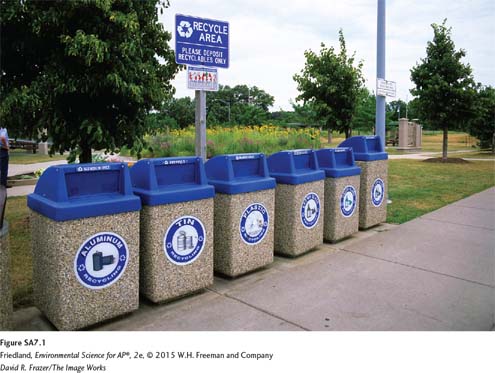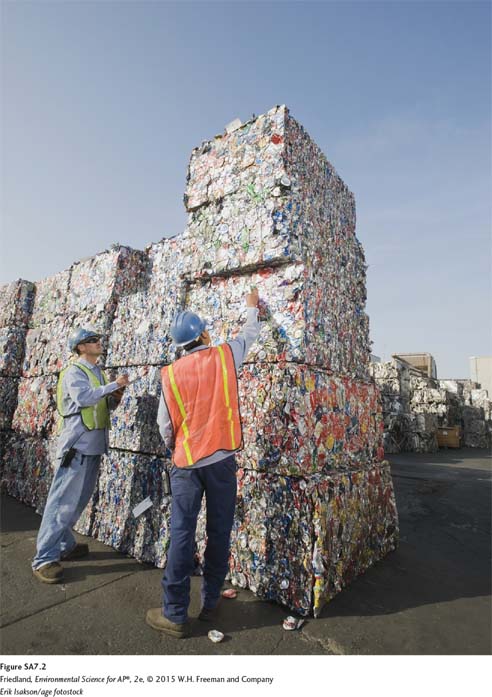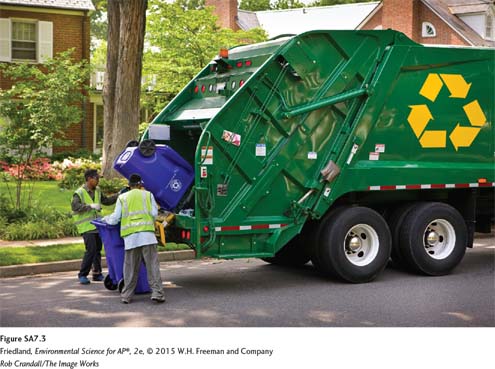7scienceapplied
627

Is Recycling Always Good for the Environment?

One of the three ways to reduce solid waste is to recycle. As we discussed in Chapter 16, when we recycle items such as paper, plastic, bottles, and cans, less material ends up in landfills and fewer natural resources need to be extracted to produce these items in the future. In 2012, the EPA estimated that Americans recycle 60 million metric tons (65 million U.S. tons) of trash. This represents about 34 percent of all the trash that we generate. At first glance, recycling appears to make a lot of sense both economically and environmentally. Indeed, many state and local governments have encouraged or required recycling programs and the public generally associates recycling with being good for the environment (FIGURE SA7.1). But what do the data tell us? When we decide to recycle, what are the measurable benefits for the environment? How do these benefits compare with benefits from other decisions we make, such as the type of car we drive? The answers to these questions may surprise you.
How do we begin to assess the benefits of recycling?
To determine the overall effect of recycling any type of waste, we need to consider the full range of costs and benefits of recycling and then compare these with the costs and benefits of manufacturing the same item from raw materials. For example, to assess the benefits of recycling paper, we need to compare the cost of recycling old paper into new paper products versus the cost of manufacturing new paper products from trees.
As we saw in Chapter 16, the best way to answer these questions is to complete a life-

The recycling of aluminum, primarily from aluminum cans, is widespread in the United States. According to the Aluminum Association, more than 60 billion cans were recycled in the United States in 2012, which represents nearly 70 percent of all aluminum cans that were manufactured in that year (FIGURE SA7.2). To manufacture aluminum cans from raw materials, aluminum ore or bauxite must be mined and processed into pure aluminum. Not only does mining have environmental impacts as discussed in Chapter 8, but this processing of aluminum from ore also takes a substantial amount of energy. In contrast, manufacturing aluminum cans from recycled cans requires only 5 percent of this energy. In short, making new cans from recycled cans saves a large amount of energy and therefore saves manufacturers a lot of money. In fact, according to the EPA, recycling 0.9 metric ton (1 U.S. ton) of aluminum cans saves about 32 barrels of oil. When this energy comes from burning fossil fuels, it also means that manufacturing recycled cans reduces the amount of carbon dioxide and other pollutants in the atmosphere. Moreover, aluminum can be recycled over and over again without any loss of quality.
628
The recycling of plastic containers is also widely practiced. According to the American Chemistry Council and the Association of Postconsumer Plastic Recyclers, the recycling of plastic continues to grow each year with 1.3 billion kilograms (2.8 billion pounds) of bottles recycled in 2012, representing 30 percent of all plastic bottles that are manufactured. The cost of energy required to make new plastic bottles from raw material—
What other costs of recycling do we need to consider?
Regardless of the type of material that is being recycled, we have to remember that there are several additional costs of recycling beyond the cost of energy used in manufacturing. To understand these costs, let’s start at your house. If you rinse out your cans and bottles before recycling, energy is needed to get the water to your sink, particularly if you use hot water. If you use hot water to rinse out the peanut butter from a plastic peanut butter jar, for example, you are likely using more energy to clean the jar than is saved when you recycle the jar.

After they are cleaned, the materials to be recycled must be transported to a central recycling facility. Depending on location, the homeowner must either set out recycled items on the curb for pickup by a collection truck (FIGURE SA7.3) or bring them to a central facility. Both scenarios require burning fossil fuels for transportation. Additional fossil fuels must be consumed to transport the recycled items from the collection facility to the manufacturing facility. Although transportation costs will vary among different towns and cities, in terms of energy consumed and pollutants produced, they reduce the benefits of recycling. However, we can easily compare the cost of transporting recycled materials to manufacturers against the cost of transporting raw materials from their source, such as an aluminum mine. In addition, when homeowners pay for transporting the items to the collection center through taxes or trash collection fees, they will avoid the costs of putting the waste in a landfill.
629
What other benefits of recycling do we need to consider?
The primary argument for recycling is that it reduces the need for raw materials and keeps solid waste out of landfills. During the 1990s, there was a growing concern that the United States was running out of landfill space and that recycling was critical to extending the life of existing landfills. While it is true that many landfills are nearing capacity, particularly in the northeastern United States, there is still a large amount of land throughout the country that could serve as landfill space if people in those areas agreed to the construction of new landfills.
Reducing the amount of solid waste going into landfills allows existing landfills to operate longer. This, in turn, reduces the costs of closing and monitoring existing landfills. It also reduces the costs of building more landfills in the future as well as the costs of trucking the waste to new landfills likely to be farther away. Increased trucking raises both the economic cost and the environmental impact.
When we consider how we can improve the environment it is often helpful to gather the scientific data to make objective comparisons rather than simply make decisions based on perceptions. In the case of recycling, the analysis of the data makes it clear that recycling certain materials will have much greater environmental and economic benefit than recycling other materials. This helps us understand why manufacturers might be much more inclined to promote the recycling of certain items such as aluminum cans. Identifying the full range of costs and benefits also helps us identify the complexity of the question. The energy costs of recycling, for example, are wide-
Questions
Question 206.1
1. Why is it much more beneficial to recycle aluminum than plastic?
Question 206.2
2. Why is it important to take a life-
Free-
Write your answer to each part clearly. Support your answers with relevant information and examples. Where calculations are required, show your work.
Suppose you are planning a party and want to determine the most environmentally friendly way to serve drinks to your friends. You can choose either one-
List four factors that are likely to increase or decrease the environmental benefits of using recyclable plastic cups. (2 points)
Suggest three reasons why using plastic cups at a party may be less environmentally costly than using glass cups. (3 points)
To reduce the amount of waste that ends up in landfills, engineers have developed plastic cups made with oxo-
biodegradable plastic that are designed to be composted. However, many of them end up in landfills because people do not have compost piles or do not understand that they can be composted. Despite their biodegradability, these cups persist for many years in landfills. Why might biodegradable plastic persist in a landfill for a long time? (2 points) Suggest one method to reduce, one method to reuse, and one method to recycle waste at your party. (3 points)
References
Aluminum Association. 2012. Aluminum continues leadership in sustainable packaging as most recycled beverage container. October 24. http:/
Association of Postconsumer Plastic Recyclers. 2012. 2012 United States National Postconsumer Plastics Bottle Recycling. http:/
Friedland, A., et al. 2003. Personal decisions and their impacts on energy use and the environment. Environmental Science and Policy 6:175–
Municipal Solid Waste Generation, Recycling, and Disposal in the United States: Facts and Figures for 2011. http:/